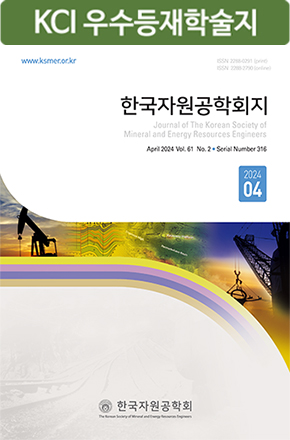- 김기동, 2006, 지리정보시스템(GIS)을 이용한 폐탄광 지역의 지반침하 예측 및 검증, 박사학위 논문, 연세대학교, 서울.
- 김종우, 송원경, 장광택, 2007, “지하갱도가 지반침하에 미치는 영향에 관한 실험적 연구,” 한국지구시스템공학회지, 제44권, 제3호, pp. 208-217.
- 석탄산업합리화사업단, 2005, 정선정암지역 지반안정성 정밀조사보고서, 기술총서 2005-10, p. 18.
- 이동길, 조영도, 정용복, 송원경, 2008, “사례조사에 의한 국내 지반침하 특성분석 연구,” KIGAM Bulletin, 제12권, 제1호, pp. 1-10.
- 정용복, 송원경, 강상수, 2008, “갱도의 심도 정보만을 고려한 지반침하위험도 평가법 개발,” 터널과 지하공간, 제18권, 제4호, pp. 272-279.
- 지정배, 김종우, 2000, “원형공동의 점진적인 붕락에 따른 지표침하 특성,” 터널과 지하공간, 제10권, 제1호, pp. 33-44.
- 최성웅, 김재동, 최광수, 2009, “폐광산 지역에서의 지반침하예측을 위한 퍼지추론기법 적용 연구,” 터널과 지하공간, 제19권, 제5호, pp. 463-472.
- 최성웅, 전양수, 박의섭, 정용복, 천대성, 2005, “지반침하메커니즘 분석 및 평가 프로그램 개발,” 터널과 지하공간, 제5권, 제3호, pp. 195-212.
- 최요순, 박형동, 선우춘, 정용복, 2009, “인도네시아 파시르석탄 노천광산의 사면붕괴 위험도 평가를 위한 퍼지 이론과 계층분석절차 기법의 적용,” 한국지구시스템공학회지, 제46권, 제1호, pp. 45-60.
- 최요순, 선우춘, 박형동, 2006, “광해방지를 위한 대규모 석탄 노천광의 배수설계 최적화,” 한국지구시스템공학회지, 제43권, 제5호, pp. 429-438.
- 최종국, 김기동, 이사로, 김일수, 원중선, 2007, “GIS 및 확률모델을 이용한 폐탄광 지역의 지반침하 위험 예측,” 자원환경지질, 제40권, 제3호, pp. 295-306.
- 한국광해관리공단, 2008, 한국형 광산지역 지반침하의 안정성 평가기법 및 소프트웨어 개발, 기술총서 2008-43, pp. 123-125.
- 한국광해관리공단, 2009, 광해방지사업 기초자료 확보를 위한 연구보고서, p 88.
- Akgun, A., Dag, S. and Bulut, F., 2008, “Landslide susceptibility mapping for a landslide-prone area (Findikli, NE of Turkey) by likelihood-frequency ratio and weighted linear combination models,” Environmental Geology, Vol. 54, pp. 1127-1143.
- Baek, J., Kim, S. -W., Park, H. J., Jung, H. S., Kim, K. D. and Kim, J. W., 2008, “Analysis of ground subsidence in coal mining area using SAR interferometry,” Geosciences Journal, Vol. 12, No. 3, pp. 277-284.
- Bascetin, A., 2007, “A decision support system using analytical hierarchy process (AHP) for the optimal environmental reclamation of an open-pit mine,” Environmental Geology, Vol. 52, pp. 663-672.
- Choi, J. -K., Kim, K. D., Lee, S. and Won, J. -S., 2010, “Application of a fuzzy operator to susceptibility estimations of coal mine subsidence in Taebaek City, Korea,” Environmental Earth Science, Vol. 59, pp. 1009-1022.
- Esaki, T., Kimura, T. and Shikata, K., 1989, “Subsidence and environmental impacts In Japanese coal mining,” Proceedings of the 30th U.S. Symposium on Rock Mechanics (USRMS), pp. 511-518.
- Goel, S. C. and Page, C. H., 1982, “An empirical method for predicting the probability of chimney cave occurrence over a mning area,” International Journal of Rock Mechanics and Mining Sciences & Geomechanics Abstracts, Vol. 19, No. 6, pp. 325-337.
- Jung, H. -C., Kim, S. -W., Jung, H. -S., Min, K. -D. and Won, J. -S., 2007, “Satellite observation of coal mining subsidence by persistent scatterer analysis,” Engineering Geology, Vol. 92, pp. 1-13.
- Kim, K. D. Lee, S. R., Oh, H. J., Choi, J. K., and Won, J. S., 2006, “Assessment of ground subsidence hazard near an abandoned underground coal mine using GIS,” Environmental Geology, Vol. 50, No. 8, pp. 1183-1191.
- Kim, K. D., Lee, S. and Oh, H. J., 2009, “Prediction of ground subsidence in Samcheok City, Korea using artificial neural networks and GIS,” Environmental Geology, Vol. 58, pp. 61-70.
- National Coal Board, 1975, Subsidence Engineer’s Handbook, National Coal Board Mining Department, London, p. 111.
- Peng, S. S., 1993, Surface subsidence engineering, SME-AIME, Little, CO., pp. 127-133.
- Saaty, T. L., 1977, “A scaling method for priorities in hierarchical structures,” Journal of Mathematical Psychology, Vol. 15, pp. 234-281.
- Waltham, A. C., 1989, Ground subsidence, Blackie & Son Ltd, New York, pp. 49-97.
- Publisher :The Korean Society of Mineral and Energy Resources Engineers
- Publisher(Ko) :한국자원공학회
- Journal Title :Journal of the Korean Society for Geosystem Engineering
- Journal Title(Ko) :한국지구시스템공학회지
- Volume : 47
- No :5
- Pages :690-704



 Journal of the Korean Society of Mineral and Energy Resources Engineers
Journal of the Korean Society of Mineral and Energy Resources Engineers








